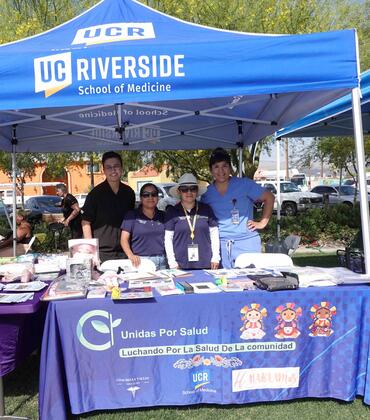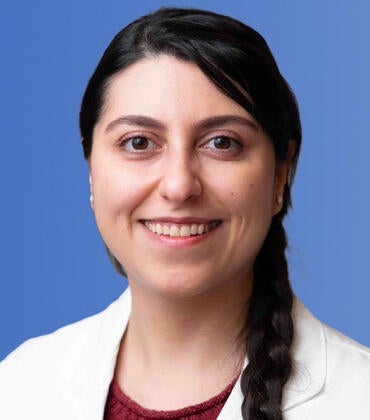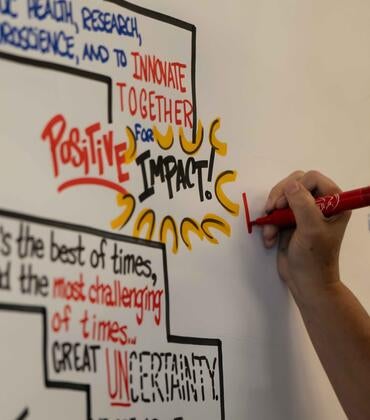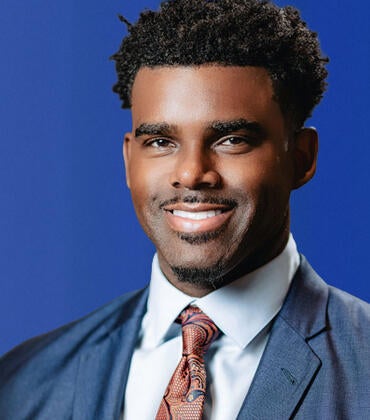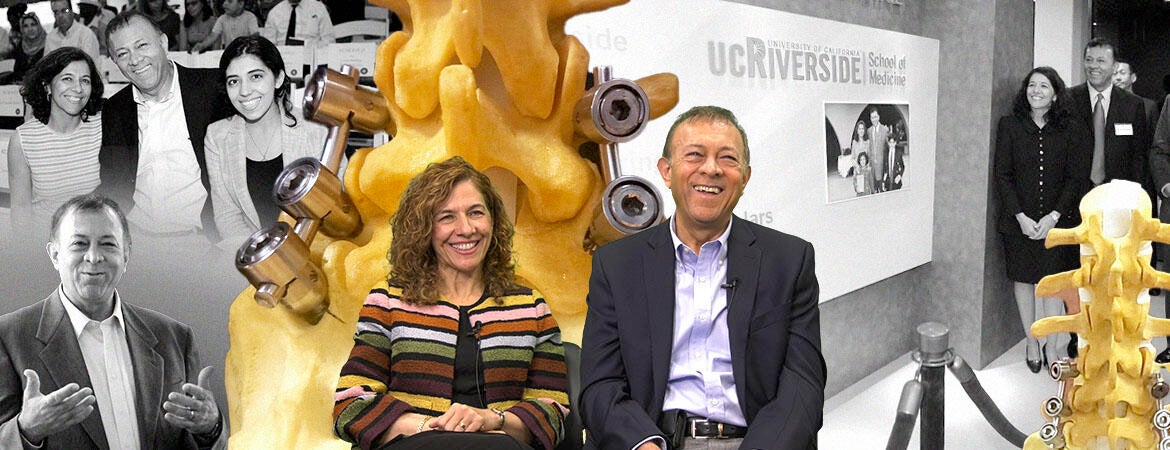
Hundreds of thousands of spinal surgeries are performed every year in the U.S., with many involving pedicle screws to stabilize the vertebrae. As patients walk around with the implanted screw—many for the rest of their lives—most are likely unaware that the proceeds from one type of pedicle screw helps fund the UC Riverside School of Medicine to improve medical care in Inland Southern California.
This pedicle screw, formally named the Haider-UCR Spinal System, was invented in 1997 by Thomas T. Haider, MD, who was seeking an improvement over the pedicle screws available at the time. Rather than a solid post that was difficult to fit to the curve of people’s backs, Haider’s invention included a joint that allowed the head of the screw to move in different directions with the spine. His goal, he recalled, was to improve surgical outcomes and help his patients.
A physician and orthopedic surgeon, Haider first came to the U.S. in 1972 to become a doctor and attended medical school in Colorado. While he planned to return to Afghanistan to practice after completing his degree, the political situation in his home country led him to stay in the U.S., eventually settling in Riverside in 1990 with his wife, Salma.
His commitment to supporting the community as a physician quickly led him to seek ways to help the local area. “My main interest in medicine is really to work with patients, serve the underserved, and make a difference in my community,” Haider said. “We wanted to do something for our new home, help out in whatever way that I could, and the university seemed to be the best vehicle for that.”
Aiding Riverside’s medically underserved community drove much of Haider’s motivation and was perfectly aligned with the eventual UCR School of Medicine’s mission. “My whole plan for the medical field was to really serve people and connect with them, and this was a perfect environment because Riverside is one of those towns where we have a large underserved community,” Haider said. Compared to coastal communities, “We don't have as many physicians as we need for this region, we don't have all the facilities, and a medical school is the best way to improve that condition and fill that gap.”
So when he created the pedicle screw a few years after moving to Riverside, it was natural to donate the proceeds to UCR in the interest of increasing medical education and care in the area. “I knew that this would be widely used; it's still widely used all over the world,” Haider said. “And so I thought the best thing to do with this was to give the royalties to UCR. This would, in my opinion, provide that energy and excitement to bring a four-year medical school here.” Eventually, Haider made a multimillion dollar donation to UC Riverside in lieu of relying on royalties coming in over a period of many years. The goal was to speed up the process of creating a medical school and instill the change he wanted to see.
The making of a medical school
At first, the invention funded the UCR/UCLA Program in Biomedical Sciences, which was established in 1974 and renamed the UCR/UCLA Thomas Haider Program in Biomedical Sciences in 1997. Through the program, UCR medical students completed their final two years of training at UCLA, earning their MD’s from the David Geffen School of Medicine.
But the program did little to benefit the Inland Empire community. “We didn't get many of those students coming back to the Riverside area to practice,” Haider said. “Once we lose them, they're gone.”
Instead, he and Salma dreamed of a full medical school at UCR. “Raymond Orbach was the chancellor at that time, and we were told that our dream of bringing a medical school to UC Riverside may be a reality at some point,” Haider recalled around the naming of the Haider Program. “Anytime you brand something, then it will reach the goal and go where you want it to go. And our goal was to have a medical school here, so this was the first step.”
It wasn’t an easy process. Haider said the UC Board of Regents suggested simply increasing the class size of the Haider Program rather than opening a new medical school at UCR. “We came back with studies that were done really showing how physicians or young physicians make their decisions where to practice. So if we increase the class size at another UC, we would not get those physicians coming back to Riverside,” Haider said. “We needed the school here, so people will feel like this is their home just like we do. And then they decide to practice here.”
There were other challenges, too. While Orbach was supportive, Haider said the chancellor initially wasn’t optimistic about opening a new medical school. As a UCR board trustee, Haider promoted the medical school to the UC president, Richard C. Atkinson, while Orbach helped the school move forward by appointing a dean. At the same time, community organizations rallied to help support the school. “It was a team effort that was to bring the School of Medicine,” Haider said. “I can't take all the credit because it was a community effort—our community organizations, politicians, UC Riverside, we all worked together on this and lobbied to the Board of Regents until finally we got a full four-year medical school.”
After years of work, the UCR School of Medicine opened in 2013–complete with an unassuming model of the screw displayed on the first floor, a nod to the school’s history of which many are unaware. “When we got our approval, once we did become a medical school, that was a very exciting time for both Salma and I,” Haider said. “It felt like winning the lottery.”
Serving the community, one student at a time
With the arrival of the first class, the school was truly underway. “When we met the first group of students that entered the school, that was really special and we will always remember that,” said Haider.
A decade later, the Haiders continue to provide scholarships to 24 to 28 Haider Scholars each year, stay in touch with medical students they have supported, and take a photo with every entering Haider Scholars class. Occasionally, Haider will encounter a former student at UCLA, where he serves as a faculty member, or at other hospitals in the area. “It's great,” he said. “It's like seeing your kids.”
For him and Salma, each student represents more than one potential new doctor for the community. “These individuals that we train as physicians, their outreach will grow exponentially to the people that they know,” Haider said, explaining that local students who attend medical school may inspire others in their area to realize they can achieve the same. The Thomas Haider Early Assurance Program operates along these lines, offering guaranteed spots at the School of Medicine for UCR students in the interest of creating doctors from local students who are already invested in the community.
Haider added that he asks every graduating Haider Scholar to mentor five people once they become a doctor. “They all give me that promise and I think they carry through,” he said. “So that way you create a lot of young kids in this community who become physicians, who become other medical providers, who now change the dynamics in their family, in their neighborhood, and in their community.”
Besides Haider’s desire to help the area he has called home for decades, this ability to truly create positive change adds to his decision to support UCR. “I think from a donor’s perspective, you really have to look at how much impact is my donation going to make,” Haider said, explaining that donating to larger, established schools helps sustain them but may not have any notable effect. At UCR, in addition to scholarships and royalties from the pedicle screw, the Haiders’ support includes endowing The Salma Haider Endowed Chair for the Thomas Haider Program, creating the Thomas Haider Biomedical Science Endowment Fund, supporting the annual Celebration of Medical Education Gala as sponsors, and donating to student-run clinics.
“I am honored to have worked closely with Tom and Salma Haider over the past five years,” said Edna Yohannes, executive director of development at the UCR School of Medicine. “I have admired their passion towards addressing the healthcare gap in underrepresented communities of the Inland Empire. Their commitment to the UCR School of Medicine has been steadfast. Donors like them bring so much joy and inspiration to the profession of fundraising and development and I look forward to being part of this partnership for years to come.”
Haider said that donating to UCR is different from donating to other schools. “If someone makes a big donation, they're going to see the fruit of it in their lifetime,” said Haider. “They're going to see that the school will provide all this medical care to the underserved, and train these physicians that may be the first one in the family to even go to school, and the first in the family to become a physician.”
The next 10 years
The Haiders are proud of how far the UCR School of Medicine has come. “I think I speak for Salma also in that we are coming up for the 10-year anniversary of the medical school, and it’s the greatest feeling a person could have,” Haider said, comparing the feeling to raising a child and watching them grow up, graduate college, and start their own family. “For us, UCR has been that type of experience. And it continues to make us happier every day with what they are doing.”
Deborah Deas, MD, MPH, the Vice Chancellor for Health Sciences and the Mark and Pam Rubin Dean of the School of Medicine, expressed her gratitude and admiration for Thomas and Salma Haider. "Their ongoing generosity and support helped lay the foundation for UCR’s medical school and improve medical care in Inland Southern California,” she said. “We are deeply grateful for their commitment to the community and the future of medical education."
In the future, Haider hopes to see an even bigger community health impact with a UCR hospital. “That is a very lofty goal, and a very aggressive goal,” he said. Once the school makes more progress on developing its specialties and increasing its class size, he believes the next natural step is a hospital–and he looks forward to seeing it happen. “I’m very optimistic,” he said. “I think it's inevitable.”
